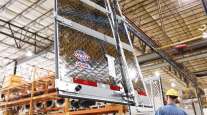Features Editor
Trailer Technology Moves Forward
[Stay on top of transportation news: Get TTNews in your inbox.]
Some say that innovation is simply taking A, B, C and D, which already exist, and putting them together in a form called E. If you haven’t noticed by reading the news or looking around your business districts, there’s a lot of change going on.
That change in its collective parts, whether it’s social or industry, is always the fuel that spurs innovation. It’s the simple process of addressing current issues and crafting proper solutions for a better outcome.
Trailer management is no different. While listening to a presentation by Paul Menig, executive director of the Transportation Safety Equipment Institute, I learned about the innovative future of trailer technology.

Freeze
“Trailers are the big topic right now,” Menig said during the Technology & Maintenance Council’s Vehicle Electrical/Electronic Architecture and Fleet Benchmarking Conference on June 24. It was also the first virtual conference in the council’s history.
Menig, who chairs TMC’s S.1 Next Generation Tractor-Trailer Electrical Interface Task Force and its S.7 Next Generation Trailer Electrical Architecture Task Force, explained that as of last year, about 1.5 million out of the 6 million trailers in operation in North America — or 23% — are equipped with a telematics system to track their location and status.

“That is expected to grow to being 40% in a couple of years,” he added. “The reasons people are doing it is because they want to monitor location, know about tire pressure to save fuel, [and] they are still having problems with lost and stolen trailers.”
How can fleet managers harness technology to get a better handle on vehicle speed and improve their safety culture? Host Seth Clevenger speaks with Mathieu Boivin of E-Smart and Jonathan Hubbard of SpeedGauge. Hear a snippet, above, and get the full program by going to RoadSigns.TTNews.com.
Menig projected that smart trailer innovation will expand in the years ahead to monitor metrics such as trailer mileage, weight sensing, tire pressure and braking controls for better efficiency.
“[Fleet managers] want to reduce detention and be able to charge people for using that trailer as a warehouse. They want to sense weight to do a better job of passing by weight stations,” he explained. “And believe it or not, drivers still pick up the wrong trailer and go down the road before it’s figured out, and that wastes a lot of time and money as well.”
As the industry looks forward, it also has to take a look at the past to assess its path. This year, trailer manufacturers experienced a sales slowdown due to the coronavirus pandemic, which has also forced manufacturers to adjust their business processes. We take a detailed look at these challenges in this edition of Equipment & Maintenance Update, which also contains stories focusing on other emerging changes that — perhaps — are ushering in a new normal for the trucking industry.
Speaking of change, my name is Michael Freeze … the new guy at Transport Topics. I’m honored to be a part of the TT family as its features editor. As I started my career covering logistics, I’m humbled to continue my career with the leading publication of record for the trucking industry. I’m looking forward to diving deep into the issues of this industry and the changes that’ll occur. Because in this world, the only constant is change.
Want more news? Listen to today's daily briefing:
Subscribe: Apple Podcasts | Spotify | Amazon Alexa | Google Assistant | More




